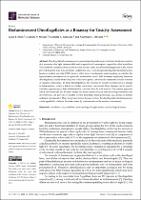Please use this identifier to cite or link to this item:
https://hdl.handle.net/20.500.12202/9602Full metadata record
| DC Field | Value | Language |
|---|---|---|
| dc.contributor.author | Oliveira, Anderson Garbuglio de | - |
| dc.contributor.author | Perin, Luíza S. | - |
| dc.contributor.author | Moraes, Gabriela V. | - |
| dc.contributor.author | Galeazzo, Gabriela A | - |
| dc.date.accessioned | 2023-12-07T15:00:43Z | - |
| dc.date.available | 2023-12-07T15:00:43Z | - |
| dc.date.issued | 2022-10-27 | - |
| dc.identifier.citation | Perin, L. S., Moraes, G. V., Galeazzo, G. A., & Oliveira, A. G. (2022). Bioluminescent dinoflagellates as a bioassay for toxicity assessment. International Journal of Molecular Sciences, 23(21). https://doi. org/10.3390/ijms232113012 | en_US |
| dc.identifier.issn | 1661-6596 | - |
| dc.identifier.uri | https://www.mdpi.com/1422-0067/23/21/13012 | en_US |
| dc.identifier.uri | https://hdl.handle.net/20.500.12202/9602 | - |
| dc.description | Scholarly article / Open access | en_US |
| dc.description.abstract | Dinoflagellates bioluminescence mechanism depends upon a luciferin–luciferase reaction that promotes blue light emission (480 nm) in specialized luminogenic organelles called scintillons. The scintillons contain luciferin, luciferase and, in some cases, a luciferin-binding protein (LBP), which prevents luciferin from non-enzymatic oxidation in vivo. Even though dinoflagellate bioluminescence has been studied since the 1950s, there is still a lack of mechanistic understanding on whether the light emission process involves a peroxidic intermediate or not. Still, bioassays employing luminous dinoflagellates, usually from Gonyaulax or Pyrocystis genus, can be used to assess the toxicity of metals or organic compounds. In these dinoflagellates, the response to toxicity is observed as a change in luminescence, which is linked to cellular respiration. As a result, these changes can be used to calculate a percentage of light inhibition that correlates directly with toxicity. This current approach, which lies in between fast bacterial assays and more complex toxicity tests involving vertebrates and invertebrates, can provide a valuable tool for detecting certain pollutants, e.g., metals, in marine sediment and seawater. Thus, the present review focuses on how the dinoflagellates bioluminescence can be applied to evaluate the risks caused by contaminants in the marine environment. | en_US |
| dc.description.sponsorship | Acknowledgments: We are grateful to the Institute of Oceanography at the University of São Paulo (IO-USP) for providing the facilities for the conduction of the data analysis and the agencies São Paulo Research Foundation (FAPESP) and Higher Education Personnel Improvement Coordination (CAPES) for the financial support. | en_US |
| dc.language.iso | en_US | en_US |
| dc.publisher | MDPI | en_US |
| dc.relation.ispartofseries | International Journal of Molecular Sciences;23(21) | - |
| dc.rights | Attribution-NonCommercial-NoDerivs 3.0 United States | * |
| dc.rights.uri | http://creativecommons.org/licenses/by-nc-nd/3.0/us/ | * |
| dc.subject | circadian cycle | en_US |
| dc.subject | scintillons | en_US |
| dc.subject | biotechnological applications | en_US |
| dc.subject | ecotoxicological assays | en_US |
| dc.title | Bioluminescent dinoflagellates as a bioassay for toxicity assessment | en_US |
| dc.type | Article | en_US |
| dc.identifier.doi | https://doi. org/10.3390/ijms232113012 | en_US |
| dc.contributor.orcid | 0000-0003-1752-0726 | en_US |
| local.yu.facultypage | https://www.yu.edu/faculty/pages/oliveira-anderson | en_US |
| Appears in Collections: | Stern College for Women -- Faculty Publications | |
Files in This Item:
| File | Description | Size | Format | |
|---|---|---|---|---|
| Oliveira OA 2022 Bioluminescent ijms-23-13012-v2.pdf | 646.19 kB | Adobe PDF |  View/Open |
This item is licensed under a Creative Commons License

